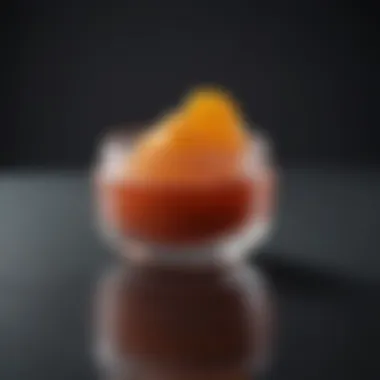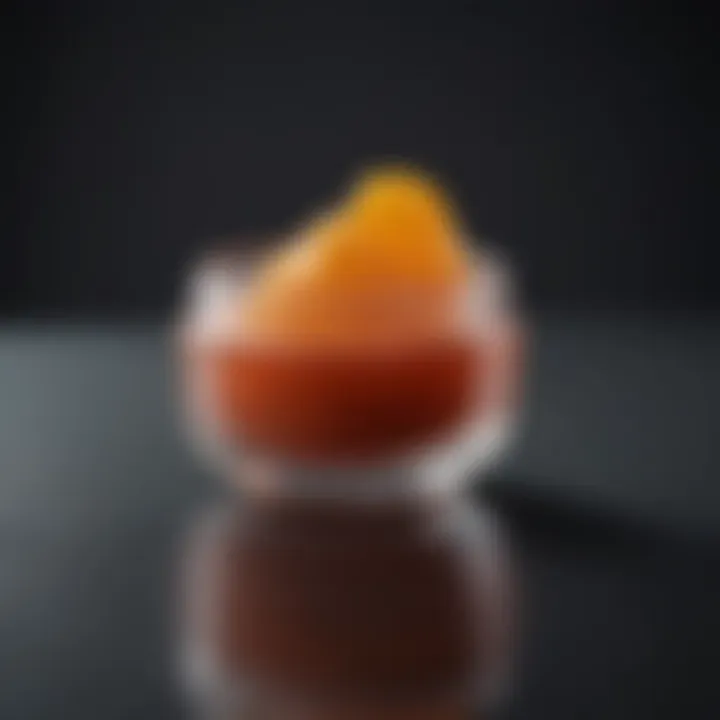Exploring Betadine Ointment: Uses and Benefits


Intro
In medical practice, the use of topical antiseptics is crucial for effective infection control. Betadine ointment stands out in this category due to its broad spectrum of antimicrobial activity and versatile application. This article aims to unpack the various uses of Betadine ointment, focusing on its constituent components, mechanisms of action, and diverse applications in clinical settings. By gaining a keen understanding of Betadine, healthcare professionals andLaypersons alike can make informed decisions about its usage.
Key Findings
Major Results
Betadine ointment is primarily composed of povidone-iodine, a complex that releases iodine when applied to the skin. This formulation contributes to its effectiveness against bacteria, viruses, fungi, and protozoa. Numerous studies indicate that topical application can significantly reduce microbial counts in infected wounds, thereby hastening healing processes. Furthermore, surveys show high levels of satisfaction among users when employed as a preventive measure in surgical settings.
Discussion of Findings
The significance of Betadine ointment cannot be overstated. Its mechanisms involve not only the direct antimicrobial activity but also the enhancement of local wound care. The release of iodine assists in creating an inhospitable environment for pathogens, which is essential in both acute and chronic wound management. Additionally, its applicability extends to preoperative antisepsis, where it serves as a barrier against operative site infections.
Applications
- Wound Care: Betadine is widely used for treating minor cuts, scrapes, and abrasions. Its antiseptic properties help in preventing infection in open wounds.
- Skin Infections: Conditions such as impetigo or folliculitis may benefit from Betadine ointment to prevent further bacterial growth.
- Preoperative Use: Surgeons frequently recommend Betadine for skin preparation prior to surgeries, minimizing perioperative infection risks.
Methodology
Research Design
The insights compiled herein stem from a comprehensive review of existing literature and clinical trials revolving around Betadine ointment. This enables a well-rounded understanding of its efficacy and scope in medical applications.
Data Collection Methods
Information was gathered from authoritative sources, including academic journals, online medical databases, and consensus guidelines published by health organizations. This ensures a robust platform of accurate and relevant data, manipulating the findings to address varying contexts within healthcare.
"Understanding the role of Betadine ointment in infection prevention and treatment can significantly improve patient outcomes when utilized correctly."
In summation, the exploration of Betadine ointment encompasses essential knowledge for healthcare professionals. Reviewing its components, applications, and clinical significance allows for a deeper comprehension, ensuring better care for patients in need.
Prelims to Betadine Ointment
Betadine ointment holds a significant position in the realm of topical antiseptics. Its role cannot be understated, especially in medical and everyday settings. Understanding Betadine’s properties and uses is crucial not just for healthcare professionals, but also for the general public who may face situations that require quick first aid intervention.
Betadine is primarily known for its effective antiseptic qualities, which help prevent infections and support wound healing. Its composition and mechanism of action play a central role in this effectiveness. Moreover, the rich history of Betadine reveals its evolution and acceptance in various medical fields. This adds a layer of depth to the understanding of how this ointment has become a staple in both hospital settings and home first aid kits.
The benefits of Betadine extend beyond mere antiseptic use; they include pain relief, fast action, and a broad spectrum of effectiveness against various pathogens. As the article unfolds, it will explore these elements, delving into the nuances of its advantages, historical context, and widespread application.
Definition and Composition
Betadine ointment is a topical antiseptic made primarily of povidone-iodine, an iodine complex. This formulation is designed to release iodine slowly, thereby providing a sustained antiseptic action.
The use of povidone-iodine is significant due to its broad-spectrum antimicrobial activity. This means it can tackle various bacteria, viruses, fungi, and protozoa, making it a versatile option for treating infections. Besides povidone-iodine, Betadine ointment contains various excipients that help support skin absorption and improve consistency, ensuring effective application.
"The iodine in Betadine provides a potent antimicrobial effect, which is essential for infection control in wounds."
History of Betadine
The origins of Betadine date back to the 1930s when it was first introduced for medical use. Developed by Dr. Max M. Noury, this ointment arose from the need for a safe alternative to pure iodine, minimizing tissue irritation. Significant studies throughout the decades demonstrated its safety and efficacy in wound care and surgical settings.
As the years passed, Betadine positioned itself as a trusted choice not just among healthcare professionals, but also for home care. It gained popularity during notable historical events, such as World War II, where it was used extensively in treating battlefield injuries.
Today, Betadine remains a critical tool in modern medicine, attesting to its reliability and timeless value in preventing infections.
Mechanism of Action
Understanding the mechanism of action of Betadine ointment is essential. It provides clarity on how this topical antiseptic effectively performs its functions. By grasping its workings, users can better appreciate its benefits, as well as considerations for safe usage.


Active Ingredients
Betadine ointment primarily contains povidone-iodine as its active ingredient. Povidone-iodine is a complex of iodine, which provides its antiseptic action. It releases iodine when applied to the skin. This process results in the destruction of various microorganisms, including bacteria, viruses, and fungi. Because of its broad-spectrum antimicrobial activity, it is often preferred in clinical settings.
The concentration of povidone-iodine in Betadine ointment is typically 10%. This concentration is effective for many applications without causing significant irritation to the skin. The formulation is designed to be stable, allowing for prolonged release of iodine, which enhances its effectiveness over time.
Antiseptic Properties
The antiseptic properties of Betadine ointment stem from its ability to disrupt the cellular structure of microorganisms. When iodine is released, it interacts with proteins and nucleic acids, leading to cell death. This characteristic is significant for wound care, as it not only disinfects but also aids in preventing infections during the healing process.
Betadine serves multiple purposes in clinical practice:
- Prevention of infections: By killing pathogens at the wound site, Betadine helps in maintaining a clean environment conducive for healing.
- Reduction of biofilm formation: Its active ingredient can disrupt biofilms, which are clusters of microorganisms that can hinder the healing process.
- Versatility: Suitable for various types of applications, ranging from minor cuts to surgical sites, its broad-spectrum activity makes it a preferred choice.
"Antiseptic agents like Betadine play a crucial role in medical settings, particularly in maintaining aseptic conditions."
Primary Uses of Betadine Ointment
The use of Betadine ointment is important in various aspects of medical care. It serves not only as a topical antiseptic but also plays a critical role in wound management, treatment of skin infections, and preoperative preparations. Understanding these primary uses helps in leveraging the full potential of this antiseptic in both clinical and home settings.
Wound Care Management
Cleaning and Disinfecting Wounds
Cleaning and disinfecting wounds is one of the fundamental applications of Betadine ointment. This process is essential for preventing further damage to the tissue and stopping the growth of pathogens. Key characteristics of this solution include its broad-spectrum antimicrobial action, which effectively targets various bacteria and fungi. Betadine is particularly popular for its efficacy in wound cleaning. Notably, its iodine content provides a unique browning effect that signals its presence on the skin.
Advantages of this feature include immediate visual confirmation of application, which can enhance care routines. However, some individuals may experience skin irritation due to iodine sensitivity, making it important to assess individual reactions when using it.
Preventing Infections
Preventing infections is critical in wound care, especially for cuts and abrasions. Betadine acts as a preventative measure against infection by creating a protective barrier over the wound, inhibiting bacterial colonization. The beneficial characteristic of this method lies in its ability to not only treat existing wounds but also protect them during the healing process.
The unique feature of Betadine’s preventative properties includes its sustained antimicrobial effect, which can last several hours. This extended coverage plays a significant role in the healing journey, offering safety for the user. However, it is essential to properly apply an appropriate amount. If used excessively, it may lead to skin discoloration or irritation.
Skin Infections Treatment
Fungal Infections
Fungal infections are a common ailment treated with Betadine ointment. Its antifungal properties make it a suitable choice for various conditions such as athlete's foot and ringworm. Key characteristics of this ointment include its capability to penetrate the skin’s layers. This ensures effective action against fungal pathogens.
Betadine’s broad antifungal landscape is why it is a popular choice in many treatment protocols. The unique feature of this solution is its ability to target both superficial and deeper fungal infections effectively. However, while it is generally safe, prolonged use might lead to skin irritation or allergic reactions in some cases.
Bacterial Infections
Specific bacterial infections like those seen in acne or minor skin boils can be treated using Betadine ointment. Its active components target a wide range of bacteria. The beneficial aspect of utilizing Betadine lies in its rapid action against bacterial growth.
A noteworthy feature of using Betadine for bacterial infections is its ability to provide immediate relief and reduce inflammation. While effective, there is a slight risk of dermatological reactions, underlying the need for judicious application based on individual skin tolerance.
Preoperative Antisepsis
Surgical Site Preparation
Proper surgical site preparation is crucial for any operation, and Betadine plays a key role in this process. It effectively disinfects the area to minimize the risk of post-surgical infections. Key characteristic of this preparation includes rapid microbial reduction. This ensures the surgical team is starting with a clean slate.
The unique feature of Betadine in this context is its sweeping action against multiple pathogens, offering broad safety for patients undergoing surgery. Additionally, it offers sterile confidence to healthcare professionals, knowing they are significantly lowering infection risks. However, if not washed off appropriately before the procedure, it may cause staining on tissues or instruments, which needs careful consideration.
Reducing Infection Risk
Reducing infection risk, particularly during surgical procedures, is paramount. Betadine is instrumental in this success. Its key characteristic lies in its capacity to target bacteria right before surgeries, thereby severely limiting infection chances.
One unique aspect of this is its relatively long-lasting effect, which can be beneficial during lengthy procedures. Nevertheless, potential disadvantages include possible allergic reactions and the need for preoperative assessment to identify any iodine sensitivity.


Betadine ointment is a valuable tool in many healthcare settings, owing to its multifaceted uses in wound care, infection prevention, and necessary antisepsis protocols.
Betadine in Veterinary Medicine
Betadine ointment plays a significant role in veterinary healthcare. Its antiseptic properties make it a valuable tool in preventing infections in animals. The use of Betadine goes beyond simple wound care; it integrates into multiple protocols that aim to ensure the health and safety of pets and livestock alike.
Applications in Animal Care
In the field of animal care, Betadine is widely employed for various purposes:
- Wound Treatment: Betadine is often used to clean and disinfect wounds in animals. This is essential for preventing infections that can complicate healing. Veterinary practices routinely use Betadine to deal with cuts, abrasions, and surgical incisions.
- Skin Condition Management: It can also address skin irritations or infections in pets. For conditions like hot spots or superficial skin infections caused by bacteria or fungi, Betadine serves as a reliable antiseptic.
- Pre-surgical Preparation: Before any surgical procedure, ensuring the area is free from microbial contamination is vital. Betadine can be applied to the site to reduce the risk of infection during surgery.
These applications underscore the versatility and importance of Betadine in maintaining animal health.
Veterinary Protocols
The adoption of Betadine in veterinary protocols is grounded in its effectiveness and safety. Veterinarians follow specific guidelines when using Betadine:
- Dilution Guidelines: While Betadine is effective in its concentrated form, diluting it to a suitable strength can enhance its safety for use on sensitive areas, especially in larger animals.
- Application Techniques: Proper methods of application, such as using sterile gauze to apply the ointment, are crucial to avoid additional contamination of the wound.
- Post-Application Monitoring: After using Betadine, monitoring the treated area helps catch any adverse reactions early. This step is particularly important for animals that may have sensitivities.
"Use of antiseptics like Betadine is essential for effective veterinary practice, focusing on both treatment and prevention of infections."
Safety and Side Effects
Understanding the safety and side effects of Betadine ointment is crucial for ensuring its proper use and minimizing potential risks. Patients and healthcare professionals must be aware of possible adverse effects that may arise while using this antiseptic. Knowledge of these factors can enhance patient safety and promote effective treatment outcomes.
Common Side Effects
The use of Betadine ointment may result in several common side effects. These generally manifest as mild reactions. Some of the frequently reported side effects include:
- Skin Irritation: Users may experience localized redness, swelling, or itching at the site of application.
- Dryness: Some individuals find that the skin becomes drier after using Betadine ointment. This is often a result of its antiseptic properties.
- Staining of Skin: Betadine can leave a brown stain on the skin, which can be aesthetically displeasing for some users but is usually not harmful.
- Allergic Reactions: In rare instances, some may experience allergic responses, including rash or swelling beyond the site of application.
While these side effects are typically mild and self-limiting, it is important to monitor for their occurrence. If symptoms persist or escalate, it is advisable to seek medical attention.
Severe Reactions
In more serious cases, individuals may experience severe reactions to Betadine ointment. These reactions are rare but can lead to significant health concerns. Some of these severe reactions include:
- Anaphylaxis: A life-threatening allergic reaction that may include difficulty breathing, swelling of the face and throat, or rapid heartbeat. Anaphylaxis requires immediate medical intervention.
- Severe Skin Rash: This can manifest as blistering, peeling skin, or widespread rash that may require cessation of the product.
- Respiratory Issues: Some users might experience wheezing or difficulty breathing even if they are not known to have allergies. This could indicate a heightened sensitivity to the components of the ointment.
It is essential for users to follow the guidelines of usage and consult healthcare providers if they notice any severe symptoms following the application of Betadine ointment. Being aware of these potential risks promotes informed decisions regarding its use.
Contraindications and Warnings
Understanding the contraindications and warnings associated with Betadine ointment is critical for ensuring its safe and effective use. While Betadine is renowned for its antiseptic properties, certain populations and scenarios require caution. Accurately identifying who should avoid its use and recognizing potential interactions with other medications can prevent adverse reactions and enhance patient care.
Who Should Avoid Betadine Ointment?
Certain individuals may need to steer clear of Betadine ointment due to risks related to its active ingredients. People with known allergies to iodine or povidone-iodine should avoid using this formulation. Additionally, pregnant women and breastfeeding mothers should exercise caution. This is because the absorption of iodine through the skin can impact thyroid function in both mother and child.
Also, patients with pre-existing thyroid disorders, especially hyperthyroidism or hypothyroidism, should consult a healthcare professional before use. In these cases, using Betadine ointment without medical advice might lead to complications.
Moreover, use in children under the age of two should be limited. The developing skin of infants may react differently to antiseptics, and their exposure to large amounts of iodine can pose risks. Therefore, it's vital to balance the antiseptic benefits against the potential for adverse effects by considering patient history and specific conditions.
Interactions with Other Medications
Interactions with other medications can alter the effectiveness of Betadine ointment or exacerbate side effects. For instance, those taking lithium, a medication used for bipolar disorder, should avoid Betadine because it may increase the levels of lithium in the body and lead to toxicity.
Patients on other antiseptics or topical solutions that also have iodine, such as some antiseptic soaps, should check with a healthcare provider before combining treatments. Moreover, using Betadine alongside certain anticoagulants might pose risks due to potential skin irritation or abnormal responses in some patients.


It is advisable for patients to thoroughly discuss their medication lists with healthcare professionals prior to using Betadine. Taking such precautions allows for better management of health and prevents unintended complications. Adhering closely to guidelines regarding contraindications can foster safer application while still harnessing the advantageous properties of Betadine ointment.
Comparative Analysis
The comparative analysis of Betadine ointment with other antiseptics is vital in understanding its roles and limitations. This section seeks to highlight the differences, similarities, and particular advantages of Betadine compared to other antiseptic agents. The analysis provides critical insights for healthcare professionals and users, guiding informed decisions when selecting antiseptic solutions for various applications.
Betadine vs. Other Antiseptics
Hydrogen Peroxide
Hydrogen peroxide is a common antiseptic with strong oxidizing properties. It works by releasing oxygen when it decomposes, which helps to kill bacteria through oxidation. One key characteristic of hydrogen peroxide is its bubbling action when applied to wounds. This reaction can assist in removing debris from the wound, making it a useful choice for cleaning. However, hydrogen peroxide can be damaging to healthy cells, which slows down the healing process. Its use is more often limited to initial wound cleaning rather than continued management.
The primary advantage of hydrogen peroxide lies in its availability and cost-effectiveness. Its presence in many first-aid kits makes it a readily accessible option. However, the potential for cytotoxic effects raises concerns, especially in sensitive wounds, highlighting the need for caution.
Alcohol-Based Solutions
Alcohol-based solutions, including isopropyl alcohol and ethyl alcohol, are widely recognized for their germicidal properties. They are particularly effective against a range of microorganisms, including bacteria and fungi. One significant aspect of alcohol solutions is their rapid action; they can effectively kill pathogens within seconds. This feature makes them a popular choice for sanitization in surgical environments and for cleaning minor cuts.
Despite their effectiveness, alcohol-based solutions have drawbacks. They can cause drying and irritation to the skin. Furthermore, they may not be suitable for deep wounds as they do not penetrate tissues effectively. These limitations suggest a more cautious approach when choosing alcohol as a treatment option in certain contexts.
Advantages of Betadine Ointment
Betadine ointment offers a range of advantages, setting it apart from other antiseptics. One of its primary benefits is broad-spectrum effectiveness; it can target various pathogens, including bacteria, viruses, and fungi. This versatility makes it suitable for numerous applications, from routine wound care to preoperative antisepsis.
Another advantage is the retention time. Unlike hydrogen peroxide and alcohol, which evaporate quickly, Betadine forms a barrier on the skin, prolonging its antimicrobial action. This feature is especially important in clinical settings where extended protection from infection is needed.
In summary, while comparing Betadine ointment with hydrogen peroxide and alcohol-based solutions reveals distinct benefits and downsides for each, Betadine’s comprehensive efficacy and lasting protection make it a valuable antiseptic in both healthcare and home settings.
Guidelines for Usage
Understanding the guidelines for Betadine ointment is vital. This ensures it can be applied effectively and safely. Proper guidelines enhance the positive outcomes of using this antiseptic while minimizing potential side effects. Adhering to specific protocols optimizes its healing properties and plays an important role in patient safety. All users should familiarize themselves with application techniques and dosage recommendations to maximize effectiveness.
Proper Application Techniques
The application of Betadine ointment must follow certain techniques to be most effective. Begin by ensuring that the area of application is clean. This involves gently washing the wound with mild soap and water. After this, pat the area dry with a clean cloth.
When applying the ointment, use clean hands or a sterile applicator. A thin layer of the ointment should be applied directly to the affected area. Be cautious not to use excessive amounts, as this can lead to irritation. Moreover, it is essential to cover the entire wound to provide adequate protection and prevent infections. If you are treating larger areas, consider using sterile dressing after applying the ointment.
Dosage Recommendations
Dosage recommendations for Betadine ointment should be followed to avoid any complications. Generally, a small amount of ointment is sufficient for most situations. Apply it two to three times daily as needed. However, individual requirements may vary based on the specific condition being treated, the size of the area, and the patient’s overall health.
It is crucial to monitor the response after initial application. If there is an increase in redness or irritation, discontinue use and consult a healthcare provider. Always follow exact dosages recommended by a doctor or on the product label, as precise usage can significantly enhance the ointment’s benefits.
"Using antiseptics properly can drastically improve healing time and prevent complications."
Consulting healthcare providers regarding specific cases is advisable. They can offer tailored advice on application techniques and dosage specific for individual needs, ensuring safe and effective use of Betadine ointment.
Culmination
The topic of Betadine ointment encapsulates a significant aspect of modern antiseptic therapy. This article discussed the multifaceted properties and applications of Betadine ointment, demonstrating its critical role in wound care and infection prevention. The key reasons for utilizing this product stem from its effective antiseptic capabilities, its versatility in various medical settings, and its presence in both human and veterinary medicine.
Summary of Findings
Throughout the article, several important points emerged:
- Composition and Mechanism of Action: Betadine ointment contains Povidone-Iodine, which acts effectively against a broad spectrum of microbes, aiding in disinfecting wounds and treating skin infections.
- Varied Applications: Its utility extends to wound care management, treatment of bacterial and fungal infections, and preoperative antisepsis, highlighting its essential role in both healthcare and veterinary practices.
- Safety Considerations: Understanding the potential side effects and contraindications is crucial for healthcare providers and users alike. The importance of proper application techniques and dosage recommendations cannot be overstated, as improper use may lead to adverse reactions.
These findings underscore the relevance of Betadine in clinical practice and everyday scenarios, emphasizing its effectiveness and safety when used appropriately.
Future Directions in Research
The study of Betadine ointment opens several pathways for future investigation. Areas worth exploring include:
- Enhanced Formulations: Research into improved formulations that may increase efficacy or reduce side effects could provide more options for users, especially in areas requiring long-term treatment.
- Combination Therapies: Investigating the synergistic effects of Betadine with other antiseptics or therapeutic agents could lead to enhanced treatment protocols for complicated infections.
- Resistance Studies: The potential for microbial resistance to antiseptics like Betadine needs attention. Understanding how bacteria adapt could inform better usage strategies to maintain the drug's effectiveness.
- Broader Applications in Chemistry and Material Sciences: Exploring Betadine's properties in novel applications outside traditional medical uses may reveal new horizons for this established product.
The paths laid forth by current knowledge may lead to advancements that enhance the understanding and application of Betadine, ensuring its continued relevance in an evolving medical landscape.



